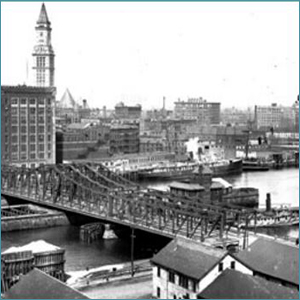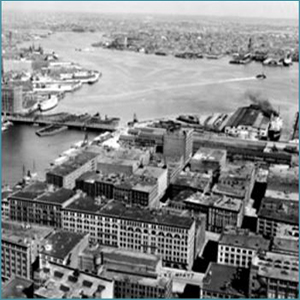History
It all started when...
Fort Point, the neighborhood, was built from the ground up, beginning in the 1830’s. The name “Fort Point’ derived from the fort of battery cannons that protected the inner harbor during the colonial times. The Boston waterfront, including the Fort Point Channel, teemed with the ocean-going sailing vessels that supported the economy of New England. By the mid-1800s, the City of Boston undertook a redevelopment project that required the leveling of the soil that was used to fill the coves on both sides of Fort Hill and the widening of the streets, in order to attract businesses.
The Boston Wharf Company was responsible for a majority of the development in Fort Point; they laid out and constructed streets, parceled out lots, and erected nearly all of the buildings. The primary purposes for the buildings were manufacturing and warehousing, with a variety of warehouse properties served by ships docking in the Fort Point Channel, Boston Harbor, and by the railroad. Among the chief industries located in the Fort Point Channel area was the wool trade. During the 19th and early 20th centuries, Boston was the principal marketplace for wool, apparel, and fabrics in the United States.
Credits: Boston Landmarks Commission
Don Eyles, Fort Point Arts Community
At the turn of the century new bridges were constructed across the Fort Point Channel at Northern Avenue, Congress Street, and Summer Street. Originally all three spans opened to allow vessels to pass through. The Channel was navigable as far as Massachusetts Avenue and the bowsprits of docked schooners extended over Albany Street in the South End. The only bridge that still opens, the Old Northern Avenue Bridge, no longer carries vehicular traffic, having been replaced by the nearby, fixed-span Evelyn Moakley Bridge.
After warehousing and manufacturing uses declined in the 20th century, artists moved into the abandoned lofts and created what is now New England’s largest artist enclave. The first artist known to have crossed the Fort Point Channel in search of a studio was sculptor Christopher Sproat, in March, 1976. Sproat and other artists had been displaced by a fire at the Plante Shoe Factory building in Jamaica Plain. Sproat brought back tales of the abundant, affordable space that was available in the sturdy timber and masonry buildings of Fort Point, still owned by the same Boston Wharf Company. The movement of artists into Fort Point sparked the transition from an industrial space to an artistically rich cultural area.
Fort Point transformed again in 2000 with the start of the “Big Dig”. The area west of A Street became a casting basin where tunnel sections were cast in concrete, then floated into the Fort Point Channel to be sunk onto prepared footings – a method unprecedented in scale, devised to protect the century-old, brick Red Line tunnel that runs down the middle of the Channel.
The Fort Point Channel Landmark District was designated by a vote by the Boston Landmarks Commission on December 9, 2008, then confirmed by Mayor Thomas M. Menino and approved by a vote of City Council on January 28, 2009.
Today, stretching from South Station to the harbor, from the Federal Reserve across three historic bridges into the old neighborhood, Fort Point is an easy stroll to Boston’s lovely Harborwalk and the Financial District. A unique and dynamic neighborhood where tradition and modern culture meet, Fort Point is a great place to live, work and play.


